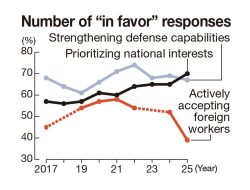6 months after Noto Peninsula Earthquake: Road map yet to be laid out for reconstruction
16:11 JST, July 1, 2024
It has been six months since the Noto Peninsula Earthquake struck. In the affected areas, little progress has been made in demolishing damaged buildings. The government should eliminate one by one the obstacles to rebuilding and support the region’s recovery.
In the northernmost part of the Noto Peninsula in Ishikawa Prefecture, which was severely damaged by the earthquake on New Year’s Day, collapsed houses and buildings have been left untouched. It is as if time has stood still for six months.
The prolonged water outage has almost been resolved, and roads are being restored, but many people still have no choice but to live in evacuation centers. Many people are also still living at secondary shelters such as hotels.
The number of disaster-related deaths, or deaths from ill health caused by evacuation, has risen to 52. Together with those who died directly from the earthquake, the number of victims has reached 281, surpassing the toll of the 2016 Kumamoto Earthquake.
Evacuation life will no doubt grow harsher as the weather gets hotter. Until August, when all temporary housing will be completed, local governments should pay close attention to the health of those affected by the disaster.
Wrecked buildings have been left unattended because of the lack of progress in publicly funded demolition programs, in which local governments demolish and remove the buildings on behalf of owners. So far, 20,000 applications have been received from owners, but only 900 buildings have been demolished.
A major obstacle is a lack of local government officials to conduct on-site inspections of houses to be demolished and to contact the owners. The owner of the house must visit the site before the demolition, but in many cases the owner has evacuated from the affected area, making it difficult to arrange a visit.
The northernmost part of the peninsula, known as the Okunoto region, is far from urban areas, and there are few places to stay, which also makes it difficult to host many demolition workers.
After the Kumamoto Earthquake, more than 4,000 buildings had been demolished within six months. Without progress on demolition, the community cannot be rebuilt.
The central government says it will set up a support base in the affected area. The government should take the lead in implementing measures such as coordination among local governments and dispatching staff to provide support.
On the peninsula, an increasing number of people have left their hometowns and rebuilt their lives elsewhere in the past six months. This may be because they feel apprehensive about the slow progress on rebuilding.
In order for those affected to move forward with hope, it is important to show them a vision of the community’s future. How will new life be breathed into the fishing and other industries and the traditional craft of Wajima lacquerware? Local governments should hurry to formulate concrete rebuilding plans.
The peninsula was grappling with a shrinking population even before the earthquake. How then can the region be made attractive? How can people be drawn to the area? It is important to thoroughly discuss the direction of recovery.
(From The Yomiuri Shimbun, July 1, 2024)
"Editorial & Columns" POPULAR ARTICLE
-

Corporate Interim Earnings: Companies Must Devise Ways to Overcome Trump Tariffs
-

Violations of Subcontract Law: Major Automakers Must Eliminate Old Practices
-

Local Governments’ Tax Revenues: Devise Ways to Correct Imbalances in Tax Sources
-

Takaichi’s Summit with Economics-Minded Trump Successfully Advanced Japan’s Security Interests
-

Lower House Budget Committee: Unrestrained Fiscal Stimulus Is Unacceptable
JN ACCESS RANKING
-

Govt Plans to Urge Municipalities to Help Residents Cope with Rising Prices
-

Japan Prime Minister Takaichi Vows to Have Country Exit Deflation, Closely Monitor Economic Indicators
-

Japan to Charge Foreigners More for Residence Permits, Looking to Align with Western Countries
-

Japan GDP Down Annualized 1.8% in July-Sept.
-

JR East Suica’s Penguin to Retire at End of FY2026; Baton to be Passed to New Character




















